How Lucky can ya be? As 2 Golden Eagles soared toward me, even above me – close – gliding on remarkably long wings along the peak of a tall butte, one turning, then the other as I followed their movements through my camera lens. How Exciting! But I stayed in the moment in spite of my heart racing as I pointed my camera at one young eagle, then the other as they approached, turned, approached again, one after another, and sometimes one extended its gliding flight until it was straight above me, close! Woo-weee! Hoka Hey!
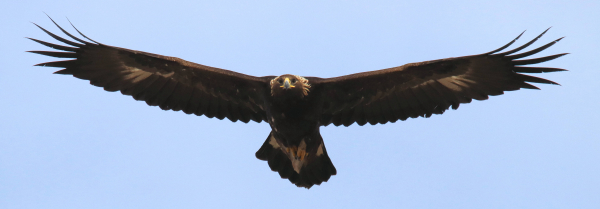
Imagine looking through your camera and lens to see a Golden Eagle approaching as you look eye to eye and marvel at its exceptional wingspan while you stand atop the highest butte in the midst of a wild landscape (600mm zoom lens, f-8 aperture, 1/3200 shutter speed, 800 ISO).
The wind was almost calm, and the eagles didn’t flinch at my presence. They even seemed to be interested in this blue flannel man with the long black eye (lens) pointing in their direction. Catching the updraft along the ridge face, the eagles were gliding silently in front of me from left to right, north to south, seemingly hanging in the fresh air overhead. Then one would shift a wing to begin a flying pivot to turn back and catch the updraft on the backside of the butte to repeat the process – one, then the other yearling Golden Eagle – WoW! This was the best Golden Eagle experience I’ve ever had in my home state, and it was happening along the Missouri River breaks about 40 miles south of my hometown of Bismarck.
I have driven this historic riverview highway untold times, and this stretch of 1 mile, where the highway climbs high above the surrounding grasslands, passing a high point on top of the tallest butte is a special place for birds of prey – and that’s where I was standing with 2 Golden Eagles gliding overhead. Last November, during the peak of late fall migration I passed through the area to photograph Whooping Cranes 10 miles north of the long butte, and at that time I was excited to find 3 adult Golden Eagles here. So it was interesting to see that in the earliest stages of spring migration, first one, then 2 yearling Golden Eagles were present.
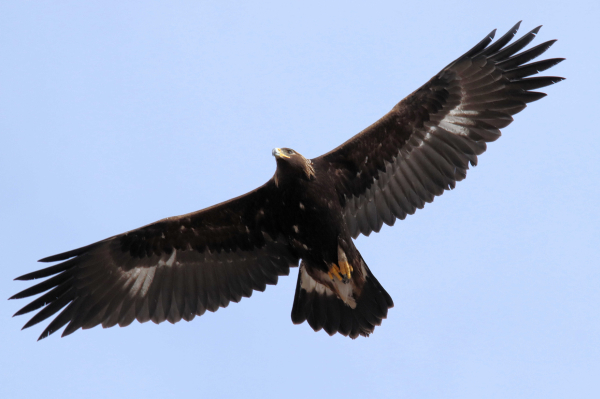
The eagle continued to glide until it was directly overhead, showing the full width of its underwing plumage and taking your breath away as your heart beats faster with adrenaline spiking during an ultimate birding experience, documented with photographs (600mm zoom lens, f-8 aperture, 1/3200 shutter speed, 800 ISO).
Certainly, this has been a raptor hotspot over the years with other Goldens, Bald Eagles, Red-tailed Hawks, Rough-legged Hawks, a Prairie Falcon, and an occasional Turkey Vulture on hand. But to be honest, it hasn’t been a good photo location in the past. The area is so expansive with beautiful views in every direction that it’s easy for birds to be evasive. But last Thursday all that changed when the first yearling Golden Eagle glided along the tallest butte in my direction, providing a few photos from a distance that was a little beyond my favored range.
In retrospect, I was overly cautious about approaching too close, although that’s a normal concern, and it’s a good practice to error on the side of caution. I try not to affect birds’ behavior, especially when a raptor is hunting or another species is foraging. After the eagle’s first pass along the butte it flew farther and farther east, higher and higher as it progressed, until it was just a spot in the distant sky.
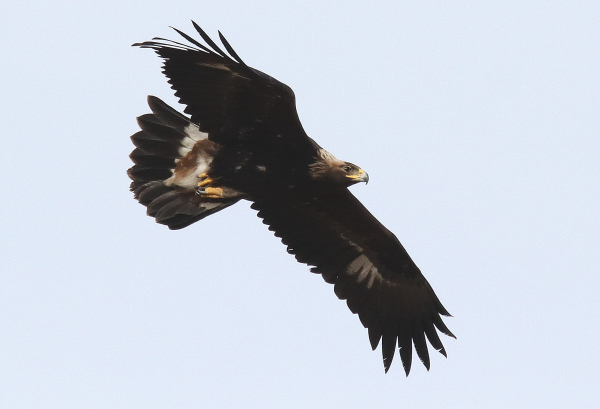
Using gravity to propel its turn, and its broadly spread tail like a rudder, this large female Golden Eagle increased its speed during a dramatic turn, then resumed a gliding position along the peak of the eagle butte – a perfect time to photograph its speeding flight (600mm zoom lens, f-8 aperture, 1/2500 shutter speed, 800 ISO).
But before I could wave goodbye, my attention was drawn to the west, where another raptor was in flight, a hawk. No, 2 hawks, and by the time a drove around to the backside of the butte, there were actually 3 hawks swirling in a single thermal, ever-rising. They were all Rough-legged Hawks, but each showed individually distinct plumage, starting with a beautifully marked male that had a mix of gray, tan, and white feathers on its head, breast and belly. The second was a dark-morph Rough-leg, and the third was a normally colored female or yearling. I quickly took photos of each of the hawks to get better looks at them later on my computer screen, and then they were gone, gliding north.
At that point my impression was that I may be witnessing the first northward migration of the season, so returned to the south base of the big butte to watch for other raptors or waterfowl. Even before I settled in, I sighted a Golden Eagle approaching the butte again. It appeared to be the same eagle returning to the butte area, flying toward the road. This time, I drove to the best position to intercept the eagle’s flight, and the big raptor was not deterred by my car parked on the side of the roadway. I photographed the Golden as it approached head-on, looking eye to eye with the big eagle, continuing as it passed above and beyond my position.
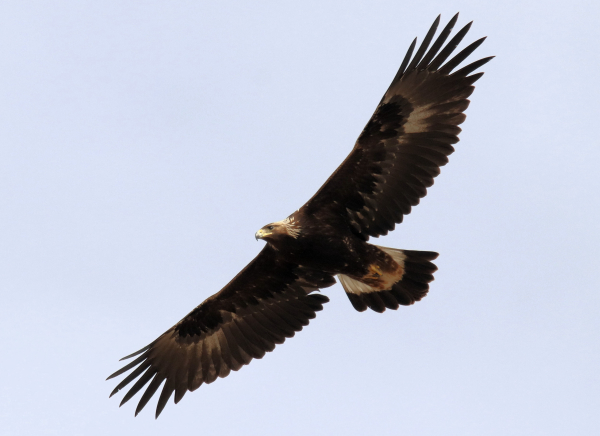
The sharp lines of the primary wing feathers are testament to the clarity of the photographs, as are the eyes. With the eagles flying overhead, their underside colors are somewhat muted, but they show how light and shadow play on a flying bird (600mm zoom lens, f-8 aperture, 1/2500 shutter speed, 800 ISO).
To my surprise, the eagle glided low to the next hump in the expansive butte and landed! I took another photo just to document the eagle’s earthly perch, then thought I would drive a couple miles north to check for other raptors, very happy to have some quality photos of the yearling Golden Eagle. Half-expecting to see other hawks or eagles migrating north, I didn’t see any more, so returned to the eagle’s high perch. I could actually see the eagle standing atop the butte from a mile away, so I decided to continue driving another dozen miles north to other previous raptor photo sites. However, I only drove about 3 miles before I had second thoughts and returned to the “eagle butte.”
It turned out to be something of a premonition, for as I approached the butte, the eagle was no longer evident, and from ¾ of a mile away I could see the eagle was flying along the butte’s ridgeline again. I needed to be there as quick as possible! When I was ¼ mile away, would you believe a second raptor appeared there? In a moment I could see it was a second Golden Eagle! Both eagles were gliding along the western ridge at the butte’s peak, and both were yearling Goldens as indicated by the white base of their tail feathers and a small area of white color on the base of some central wing feathers.
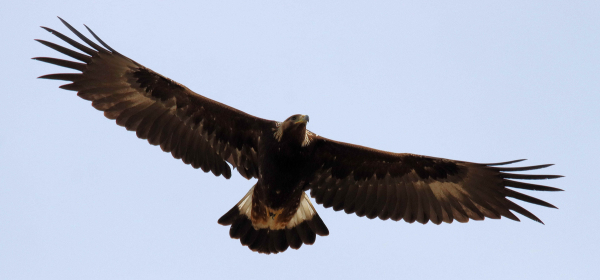
Gliding directly overhead, the broad wingspan of a Golden Eagle adds a spectacular element to this and other images of the eagle flights. It’s especially interesting to see the symmetry of the primary wing feathers as the eagle glides overhead (600mm zoom lens, f-8 aperture, 1/1250 shutter speed, 800 ISO).
When I reached the top of the butte, I actually passed by the grand gliding eagles and stopped at the best location with respect to the incoming sunlight. With the sun directly at my back, I raised my camera and lens to focus on the closest eagle as it approached my position and began photographing until after it turned away. I lowered my camera, and the original eagle followed the same pattern, providing photos and thrills galore, and when it circled away the newer (female) yearling was approaching again! How lucky was I during these special moments!
It's hard to describe what it’s like to be in a position like this as an avid birder with a camera, with the Golden Eagles seemingly interested in my presence, while accepting my presence. It was just me and the eagles atop the dramatic prairie butte. I guess the best way of describing my excitement is for you to view the photos I share in this article and put yourself in my position – as though you are looking eye to eye with an oncoming Golden Eagle, hopefully on a large-format screen like a computer screen. Then imagine the motion of the birds as they glided along the edge of the butte on the warmest day of the year to date (55 degrees).
I hope you occasionally have exciting birding episodes with your camera in hand, sharing moments with a spectacular bird or birds, so thrilled that it becomes a lasting experience for you. One you can refer to in times when you need a little pick-me-upper or a change of attitude – or just to recall one of those special moments shared with wildlife in a wildland. Good Luck, and enjoy the week ahead!
Article and Photographs by Paul Konrad
Share your bird photos and birding experiences at editorstbw2@gmail.com